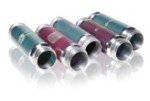We are always thinking one step aheadConsulting, Engineering & Optimization in Logistics Networks
How can we help you?
Network study reveals the importance of Supply Chain at SPGPrints
Interview with Geert Wanten, Director Operations, and Wouter Visser, Supply Chain Manager, SPGPrints.


The digital transformation is well under way in the textile and graphics printing industries, and ever-more textile companies are switching to digital printing machines. “As a result, the sale of ink is increasing by 20 to 30% a year, and last year it was as much as 50%,” says Geert Wanten from SPGPrints. As Director Operations, he is responsible for the Dutch operations and is also a board member at SPGPrints, which has production facilities in the Netherlands, Austria, India, China and Brazil.
The rise of digital printing is also creating extra supply chain complexity for SPGPrints, which manufactures not only the printing machines but provides total system solutions with a portfolio including consumables. For conventional printing machines that means screens: large rollers made of nickel. “Nickel can be purchased relatively easily in large volumes. But

for digital printing machines we produce inks in various trend-sensitive colors. They are often made from natural dyes, which means that there can be slight color variations. That’s why we have to conduct extra quality checks, resulting in longer lead times. Plus our raw material suppliers are not exactly just around the corner from us,” comments Wouter Visser, Supply Chain Manager at SPGPrints.
New production facility
The screens are produced at four facilities – in the Netherlands, India, China and Brazil – which largely manufacture for their own local regions.
So far, the inks have all been produced at the Dutch facility, which is located next door to the head office in Boxmeer. In view of the rising demand for inks, the company had started to question whether one production facility was enough.
The efficiency of the existing supply chain for screens was reconsidered too. Which SPGPrints supplies screens in various lengths of between 1.5 and four meters. “Which length we produce depends on the width of the production bath they are produced in,” explains Wanten. “In Boxmeer the production baths are four meters wide, so the standard screens are four meters long. If a customer wants a three-meter screen, we simply cut a meter off. We re-use that nickel, of course, but we’d prefer not to waste so much effort on a product that we only need part of. In Brazil we have a production line with a three-meter-wide production bath. It might be more efficient to make all of our three-meter-long screens there instead.”
Supply chain network study
In order to find the answers to those questions, SPGPrints enlisted Groenewout’s help to conduct a global supply chain network study in the spring of 2016. Visser: “We started by gathering a lot of data, including the transport flows included. We entered all the data into a model and then analyzed various scenarios. What would be the most effective approach for screens – to use the facilities in India and Brazil to produce for the local market only, or to manufacture different screen lengths at different facilities based on the dimensions of each production line? The latter scenario would reduce production costs, but would those savings outweigh the rise in transport costs and what would be the influence of import duties?”
For inks, several growth scenarios were analyzed up until 2025. Which markets would grow most strongly? And which location would then be most suitable for ink production? “We found that the majority of the growth in demand for inks is coming from outside of Europe. That creates higher transport costs because we often have to use air freight. Another significant factor is import duty, so Groenewout included that in the model,” states Visser, who is very positive about Groenewout’s approach: “The risk of such a project is that it becomes bogged down in data and details, especially within a company like SPGPrints with so many different locations, systems, cultures and interests. Groenewout succeeded in keeping the model easy to understand but also giving it the necessary depth.”
Greater insight, lower costs
The global supply chain network study took less than six months in total. The insights it provided into the current supply chain costs alone were enough to make the project worthwhile. SPGPrints’ ERP landscape is fragmented, which makes it difficult to generate reports that allow direct comparisons between the performance of the various production locations. “Gathering all the data was a mammoth task, but we’re now able to benchmark our supply chain costs against similar companies. And an added advantage is the improved collaboration between all our sales offices and production facilities. Thanks to the Groenewout study, we now talk to one another much more,” says Wanten.
Needless to say, the study also answered the question regarding which supply chain locations the company should invest in, and the board of directors took the findings into account in the strategic decision-making process. “We didn’t act on all the recommendations right away, however. For example, Groenewout advised us to set up a control tower, partly because of the fragmented ERP landscape. We haven’t done that yet, but we have started to reallocate production orders. We’re now producing more of the three-meter-long screens in Brazil,” reveals Visser. Wanten adds: “According to Groenewout we can save up to 20% on our supply chain costs. I estimate that we’re currently at around three to five percent, partly because we’ve managed to cope with the growing demand for screens without having to increase our production capacity.”
Supply Chain is increasingly important
What is perhaps the most important benefit from the study is one that cannot be expressed in financial terms: the improved collaboration between the various SPGPrints locations. Whereas the five production facilities used to operate independently of one another, they now act more as one supply chain. They have more contact with each other and share more information, including inventory management and sales & operations planning (S&OP). “We’re already thinking about potential next steps, such as integrated production planning for all our plants. Right now, they consult one another in terms of production orders and production capacity, but each facility is still responsible for its own planning,” explains Visser.
The improved collaboration has not gone unnoticed at the head office either. “At SPGPrints, we introduced supply chain management just four years ago. The study has demonstrated the importance of this discipline. There is now more acceptance for the involvement of Supply Chain across all layers of the company,” he continues. He is echoed by Wanten, who is completely satisfied with the support received from Groenewout. “I already knew Groenewout through my role at my previous employer, and I know how much relevant knowledge and experience they have. The communication was excellent, plus the project was completed on time and within budget. And this project has clearly spurred our company into action on several fronts.”
Text by Marcel te Lindert
Marcel te Lindert is a journalist with over 20 years of experience in the logistics industry. He was editor-in-chief of the Dutch magazines Transport+Opslag and Logistiek. Nowadays he works freelance for trade magazines including Supply Chain Magazine and Warehouse Totaal.
More information
If you would like more information about this project, please contact Alain Beerens or call +31 76 533 04 40. For more information about SPGPrints: www.spgprints.com





























